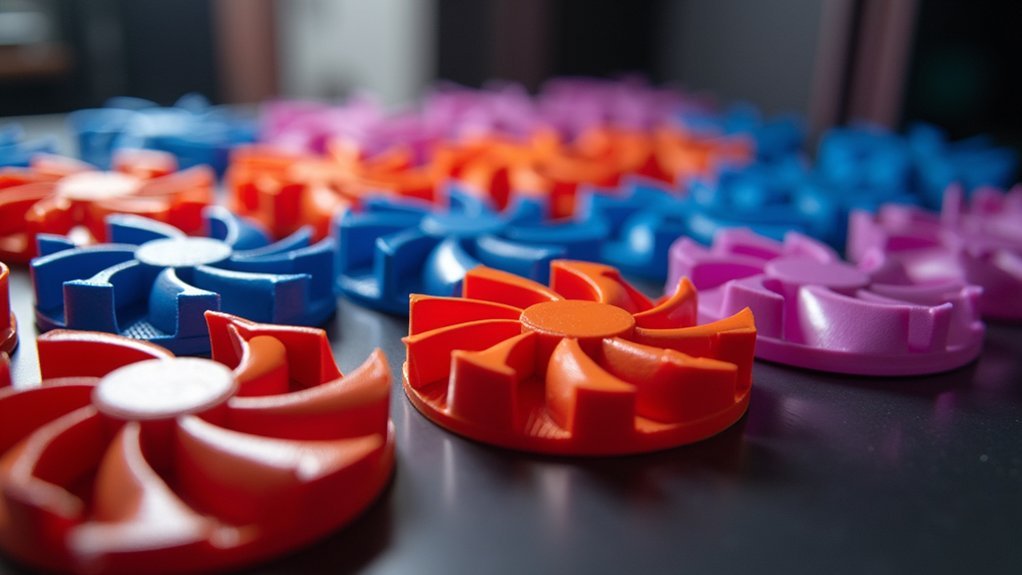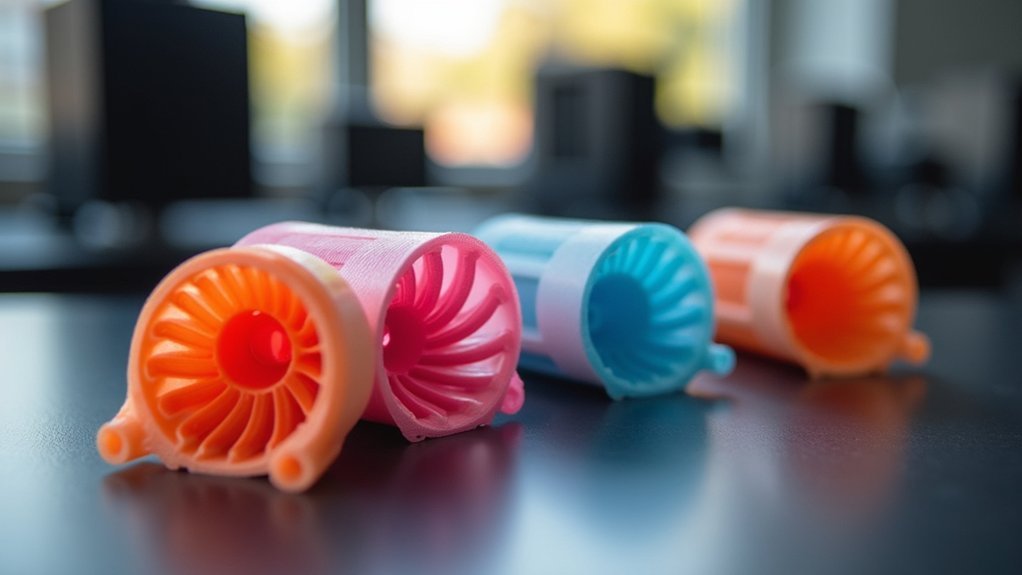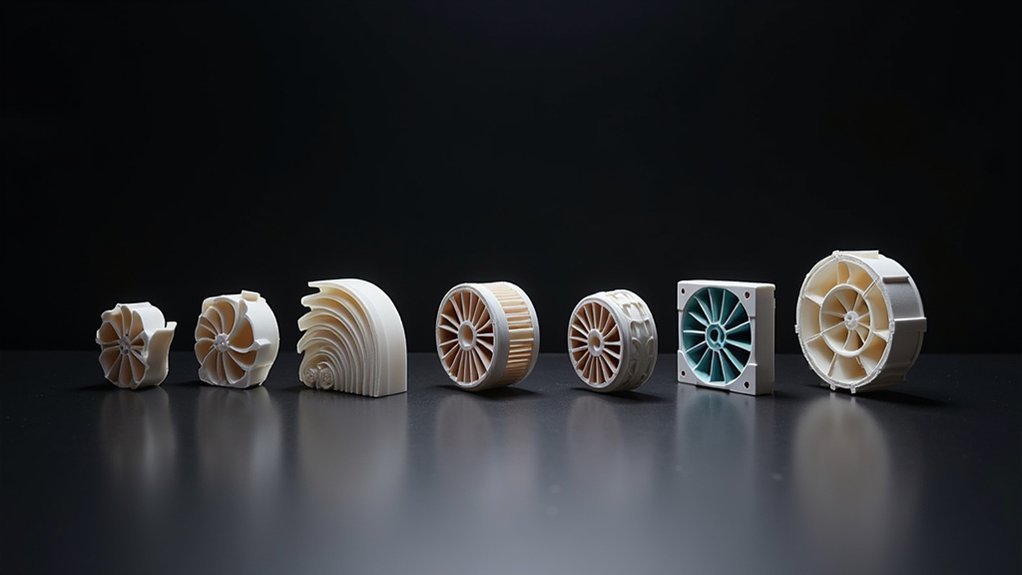You’ll find the best 3D printer cooling fan duct STLs on Cults3D, which hosts over 2.4 million designs ranging from free community models to premium options costing up to $21.85. Popular choices include the Satsana Dual Fan Duct at $11.51 and free LPA Fanduct models. Premium designs offer enhanced cooling efficiency, while free community-driven options provide excellent value for basic needs. Compatibility varies by printer model, with abundant resources for popular machines like Ender 3 Pro. The sections below reveal optimization secrets and installation best practices.
Popular Fan Duct Models and Their Features

The 3D printing community has developed numerous fan duct designs that cater to different printer models and cooling requirements.
When you’re searching for the best Fan Duct STL files, you’ll find standout options like the Satsana Dual Fan Duct, praised for its enhanced cooling efficiency and wide compatibility at US$11.51.
The Prusa XL Fan Duct Upgrade demonstrates how tailored designs optimize airflow for specific printers.
You’ll discover both free and premium models on platforms like Cults3D, which hosts over 2.4 million designs.
Each Fan Duct model serves unique 3D printing needs, from basic cooling solutions to specialty configurations.
This community-driven approach guarantees you’ll find suitable cooling upgrades regardless of your printer type or budget constraints.
Free Vs Premium STL Downloads
Budget considerations play an essential role when you’re choosing between free and premium fan duct STL downloads. Free STL downloads like the LPA Fanduct offer excellent value for basic cooling needs, while premium options can cost up to $21.85 for specialized designs like the Whatsminer M30/s/+ duct.
Community-driven models dominate the free category, encouraging users to share 3D printing ideas and contribute to ongoing development. These models provide solid performance for most applications.
However, premium STL downloads deliver high-quality designs with enhanced cooling efficiency and better compatibility with printer models.
Platforms like Cults3D host a vast collection of over 2.4 million models, giving you access to both free community contributions and professional-grade fan duct designs that match your specific requirements.
Compatibility With Different 3D Printer Models

When selecting fan duct STL files, you’ll find that compatibility varies considerably across different 3D printer models. Popular machines like the Ender 3 Pro benefit from abundant free resources on platforms such as Cults3D, offering budget-friendly cooling solutions.
Specialized designs like the LPA Fanduct for TEVO Black Widow and Satsana Dual Fan Duct demonstrate how tailored designs enhance cooling performance for specific printers.
You’ll discover that manufacturers create targeted solutions, such as the Satsana Tronxy X5SA Fan Duct, which addresses particular machine requirements. These high-quality STL files come in various formats including STL, OBJ, and 3MF, ensuring seamless integration across different 3D printer models.
Whether you’re using standard desktop printers or specialized equipment, compatible fan duct options exist to optimize your machine’s cooling capabilities.
Design Principles for Optimal Airflow Performance
Effective fan duct design goes beyond simple compatibility and requires understanding fundamental airflow principles that directly impact your 3D printer’s cooling performance.
You’ll achieve ideal airflow by prioritizing circular cross-sections that minimize airflow friction compared to rectangular alternatives.
Design gradual changes using S-shaped curves instead of sharp angles to maintain smooth connections throughout your system.
Test fan performance regularly, as each fan has specific thresholds where narrowing ducts too much compromises efficiency.
Adjust outlet size gradually to prevent throttling while remembering larger ducts typically outperform smaller ones.
When using CAD software, maintain consistent wall thickness and iterate based on community feedback to eliminate design imperfections that could disrupt airflow patterns.
Installation and Testing Your Fan Duct

Proper installation of your fan duct transforms even the most carefully designed cooling system into either a game-changer or a complete failure.
You’ll need to orient the duct correctly, directing airflow efficiency toward your print area for maximum part cooling performance. Choose a design with appropriate clearance from the bed—3mm or 5mm works best to prevent interference during 3D printing.
Start testing with calibration objects using materials like PETG or PLA at 0.20mm layer heights or smaller.
Monitor cooling performance under various fan settings, observing how effectively your installation cools overhangs and bridges. Based on results, you’ll likely need design adjustments to enhance duct shape and size.
Iterate continuously—successful fan duct installation requires multiple rounds of testing and refinement to achieve ideal airflow and cooling efficiency.
Community Reviews and Performance Comparisons
Although individual testing provides valuable insights, community reviews and performance comparisons offer broader perspectives on fan duct effectiveness across different printer models and use cases.
You’ll find valuable data from users who’ve tested popular designs like the Satsana Dual Fan Duct and Prusa XL Fan Duct Upgrade, reporting significant cooling efficiency improvements and temperature reductions that enhance print quality.
Performance comparisons consistently show that designs with smooth airflow shifts outperform those with sharp bends.
Community feedback highlights specific benefits:
- V5 versions deliver superior performance through optimized outlet sizes
- LPA Fanduct designs excel on specific printers like TEVO Black Widow
- Reduced stringing and warping when using properly designed ducts
- Empirical testing data validates cooling improvements across printer types
- Free models on Cults3D enable cost-effective experimentation
Frequently Asked Questions
Should I Be Running a Cooling Fan on a 3D Printer?
You should run a cooling fan when printing materials like PLA to prevent deformation and improve quality. It reduces stringing, helps overhangs, and maintains proper layer adhesion for detailed prints.
What Is the Best Fan Speed for a 3D Printer?
You’ll want 100% fan speed for PLA to get sharp details and good overhangs. For ABS, use 30-50% to prevent warping. Experiment with your specific printer and materials to find ideal speeds.
Is It Safe to Sleep Next to a 3D Printer?
You shouldn’t sleep directly next to a 3D printer due to fire risks from overheating, harmful fumes from materials like ABS, and disruptive noise that’ll keep you awake throughout the night.
How to Improve 3D Printer Cooling?
You’ll improve cooling by installing quality fan ducts like Satsana designs, testing circular outlets to reduce turbulence, adjusting airflow direction for specific prints, and exploring community STL designs for proven solutions.





Leave a Reply